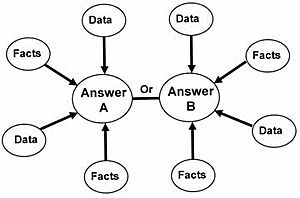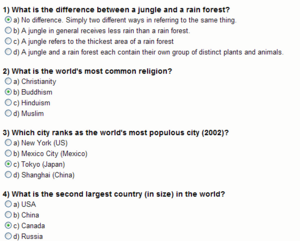Convergent thinking facts for kids
Convergent thinking is a way of thinking that helps you find the single best answer to a question. It's like when you solve a math problem and there's only one right answer. This idea was first described by Joy Paul Guilford. It's the opposite of divergent thinking, which is about coming up with many different ideas. You use convergent thinking a lot in school, especially for tests like multiple-choice tests.
Contents
What is Convergent Thinking?
Convergent thinking is all about finding the one correct answer to a problem. It helps you get to the best or most common solution quickly and logically. This type of thinking is useful when the answer is already known or can be found using clear steps. It means there's no confusion; the answer is either right or wrong. The solution you find using convergent thinking is usually the best one.
This way of thinking also connects to what you already know. It helps you use your existing knowledge with standard methods. Knowledge is important for being creative too. It gives you ideas, shows you ways to solve problems, and helps you know if your solutions are good or new. Convergent thinking is a tool used in creative problem solving. When you use critical thinking to solve a problem, you use rules or facts to make choices. This is different from divergent thinking, where you look for many possible solutions without judging them right away.
Convergent thinking often works together with divergent thinking. Divergent thinking is when you brainstorm many different ideas freely. You explore many possible solutions quickly and make unexpected connections. After you've come up with lots of ideas using divergent thinking, you then use convergent thinking. This helps you organize and choose the single best answer. For example, you might use brainstorming to get many ideas. Then, you use convergent thinking to pick the best one. You consider what you know, use logic, and other ways to make decisions. The goal is to find one clear, correct answer.
Convergent vs. Divergent Thinking
Personality and Thinking
Scientists have looked at how your personality might affect convergent and divergent thinking. They found that two personality traits are linked to divergent thinking. These are Openness (being curious and imaginative) and Extraversion (being outgoing). These traits seem to help people come up with many different ideas.
Openness is strongly connected to divergent thinking. This makes sense because openness includes being interested in new ideas and being original. So, if you like to think "outside the box", you might score high on both openness and divergent thinking tests.
However, researchers didn't find any strong links between personality traits and convergent thinking. This suggests that people use convergent thinking no matter what their personality is like.
Brain Activity and Thinking
Scientists have also studied how your brain works during convergent and divergent thinking. They used a method called Electroencephalography (EEG) to look at brain patterns. They found that different brain patterns happen for each type of thinking.
During both types of thinking, certain brain waves (Alpha rhythms) changed. But for convergent thinking, there was more connection (coherence) in some brain areas (Theta 1 band). This means the brain hemispheres worked closely together. For divergent thinking, other brain areas showed different patterns. This suggests that different parts of the brain are active depending on whether you're trying to find one answer or many ideas.
How Thinking Affects Mood
Research shows that the type of thinking you do can affect your mood. Preparing for a creative task can change how you feel.
Studies show that doing a task that needs creative thinking does impact your mood. This means that mood and thinking are connected and can influence each other. Also, divergent and convergent thinking affect mood in opposite ways. Divergent thinking often leads to a more positive mood. Convergent thinking, however, can sometimes lead to a more negative mood.
Practical Uses
Convergent thinking is a very important skill for students. Most school tests, especially multiple-choice tests, require you to use convergent thinking. When you look at the possible answers, you use convergent thinking to weigh them. This helps you find the single best solution.
Here are some examples of questions in school that use convergent thinking:
- What were the main reasons Ophelia went mad in the play Hamlet?
- What is the chemical reaction for photosynthesis?
- What are the signs that a plant doesn't have enough nitrogen?
- Which types of farm animals would do best in South Texas?
Criticisms
Some researchers have pointed out that not all problems have just one "best" answer. Convergent thinking tries to pick one solution over others. But for very complex problems, it might be hard to rank the solutions. In these cases, other things like your gut feeling or natural problem-solving skills might also help you find a solution.
Also, convergent thinking has been criticized for possibly ignoring ideas from a smaller group of people. In one study, people using convergent thinking were more likely to agree with popular ideas. They didn't pay as much attention to ideas from a minority group. This means that convergent thinkers might be so focused on finding the "best" answer that they miss good solutions from less popular opinions.
See also
 In Spanish: Pensamiento convergente para niños
In Spanish: Pensamiento convergente para niños



